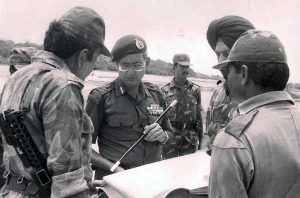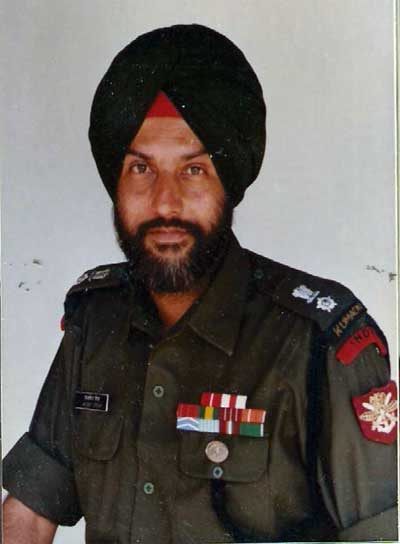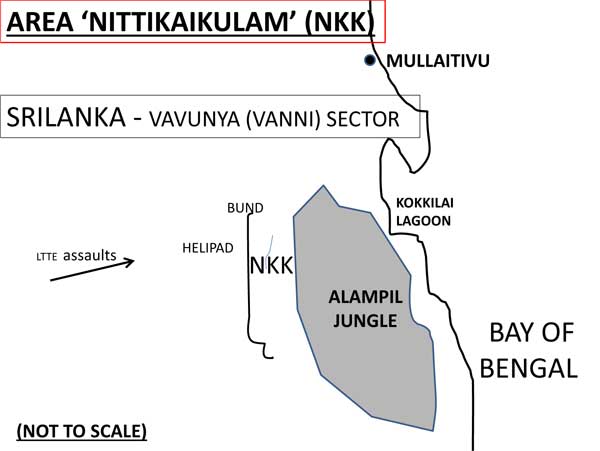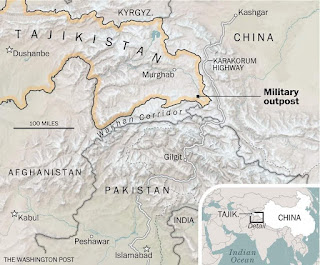IDR Blog
Gun-Fire at Nittikai-Kulam, Srilanka (1989)
In the late 1980s, the internal situation in Srilanka had deteriorated considerably and a large military force was dispatched from India to assist the beleaguered island nation. Named the Indian Peace-keeping Force (IPKF), it comprised of four infantry divisions, three battalions of Special Forces Commandos and various administrative and support elements. The IPKF was deployed in north and east of Srilanka, with an infantry division each at Jaffna, Vavuniya, Trincomalee and Batticaloa respectively. In 1988, I was posted as General Staff Officer, Grade 1 (Operations) [GSO-1 (Ops)] at HQ IPKF.
Violent clashes took place every day between troops of IPKF and LTTE guerrillas, leading to casualties on both sides. Fire of artillery guns was used sparingly by the Indian side and helicopters (MI-8/ M I-17, Cheetah and Chetak) were basically used for lifting of troops for operations, casualty evacuation and reconnaissance by commanders. The fleet of transport aircraft (IL-76 and AN-32) was used for lifting troops and stores from India (Madras, now called Chennai) to Srilanka and back. Occasionally, the attack helicopters (MI-25) and improvised attack helicopters called ‘Ranjits’ (Cheetah helicopters with 7.62mm MAG Machine Guns (MGs) were used to directly assist the ground operations by providing fire support of MGs. Occasionally even 57mm high explosive rockets were fired from the rocket pods of MI-8/MI-17 helicopters and from the MI-25 helicopter gun-ships.
The eastern, coastal areas of Vavuniya Sector comprised of a large lagoon (Kokkilai Lagoon) and some thick jungle terrain (Alampil Jungles). In June 1989, regular intelligence reports and radio intercepts were being received of large concentrations of LTTE guerrillas operating from hide-outs in this thickly forested area. Thus, concerted operations were launched to clear the area of LTTE, using an infantry brigade, Para Commandos of Special Forces and some Artillery sub-units. The nearby Indian base at Mullaitivu soon began to hum with activity, as troops were moved for the operation and artillery gun positions were prepared, artillery guns were deployed and their ammunition was dumped. Operations commenced with the coastal areas of Alampil jungles being pounded with Artillery fire, while the Commando and Infantry soldiers searched the jungles, from Nittikkaikulam (NKK) to the coastal areas.
NKK was a small, deserted village with a large pond or ‘kulam’, on the western edge of the jungle. It had a flat open area and a four to five feet high ‘bund’ running for about 30 meters, parallel to the jungle’s edge. The hot and humid weather conditions made the operations extremely difficult for the troops operating in the Alampil jungles. Drinking water was in extremely short supply and had to be supplied to the troops by helicopter. In addition, the troops had to be watchful and extremely cautious, as the thick jungle had been heavily mined and booby-trapped ingenuously by the crafty LTTE cadres. A large number of radio conversations were daily intercepted of a large number of LTTE groups, who were operating in the thick jungles. From intercepts of LTTE radio call sign of 14, it appeared that the HQ of LTTE Supremo (Prabhakaran) was located in Alampil jungles.
When this information was circulated, the troops searched the jungles with a greater vigor and ‘josh’. The booby traps had been very intelligently deployed and caused serious casualties to the troops searching the deep and dark jungles. Often there was no open area to provide for improvised helipads, so casualties had to be carefully winched up from the jungled areas, by the ‘cas-evac’ helicopters. At times of ‘cas-evac’, the surrounding area was either pounded with artillery fire or blasted with MG fire and rockets from support helicopters, to keep the LTTE guerrillas from interfering with the delicate ‘cas-evac’ operations.
I was located at IPKF Tactical HQ, Trincomalee, to monitor the ongoing operation at NKK. One morning, the reports received from HQ 4 Infantry Division (who were closely monitoring the operation) indicated that during search of the jungle at about 3 AM on the previous night, some troops of the Division had been caught in a web of booby traps, and had suffered serious casualties. Thus, it was decided that I would accompany Lt Gen AS Kalkat, GOC IPKF, and immediately proceed to closely oversee the ongoing operations from NNK itself or the nearby Brigade HQ at Mullaitivu.
So, we boarded a Chetak helicopter at Trincomalee and flew south along the east coast of Srilanka. Soon we landed at NKK. After quickly getting the latest operational details from Maj Gen AM Malik, GOC 4 Inf Div, and his staff officers, we took off again in the Chetak helicopter. We circled the Alampil jungles, flying fast and at a very low altitude-nearly at tree top level. Despite the low altitude and high speed flying, we drew some bursts of rather inaccurate fire from alert sentries of LTTE, down below us in the thick jungles.
From our low altitude flight, on looking through the thick tree cover we saw some of our troops in a small jungle clearing down below. GOC IPKF pointed at the Indian Army troops and asked the Artillery (Air OP) pilots to land the helicopter. Very deftly, the pilots did a short circuit and then dropped to the small and clear jungle patch, through a narrow cylindrical clearing in the dense tree cover. It was extremely good flying and the rotors even shaved off a few tufts of leaves from trees that bounded the circular well to the grounds. The flying machine shuddered violently as it descended and settled on the open patch of damp soil. There were some surprised troops on the ground, who quickly knelt facing outwards for our security and even lit a smoke candle.
Among the ground troops, I saw a familiar face.[1] Standing there in the bushes was this slim and tall major, who smiled brightly when he saw me alight from the helicopter, behind GOC IPKF. The helicopter had landed at the spot where troops who were searching the jungles early that morning and had struck some booby traps and land-mines, cleverly laid by LTTE. There were left-over remains of the earlier blasts, and even the gory sight of a jungle-boot containing a severed foot! The GOC recognized Maj HV Singh, whom he had earlier met at my house in Madras. He allowed me to spend some time with HV, while he looked around the gruesome site of the early morning explosions of booby traps and land mines.
I followed HV to a nearby shelter made of four Y-sticks that had been embedded in the ground and linked with a number of straight branches. With ingenuity, this structure was covered with wide brimmed leaves and fronds, to save the interior from rain drops and dew. Within the shelter, was a bed about 3 ft off the ground and made of neatly cut branches. When I appreciated the construction, HV told me the entire structure had been made by a captured LTTE soldier, who was accompanying the ‘search party’ during the operation, to indicate the presence of cleverly laid mines and booby-traps. As I was leaving for the helicopter, my friend asked me to send some drinking water. He said the water was urgently needed by all troops as they had already exhausted the meager amount of water they had carried in their water bottles. The captured LTTE soldier had confirmed that there was no spring or other source of drinking water in the vast jungle. He said there was a small, muddy stream in the north-east, near the Kokkilai Lagoon, that was used by the LTTE. HV mentioned that
drinking water was urgently needed for the casualties, especially after they had lost blood. I promised HV that I would immediately have bottles of drinking water dropped by helicopter in the jungle clearing. Little did I know that soon there would be no chopper available and I would forget to send the water, as we would be embroiled in a bitter encounter with the LTTE.
We took off from the jungle clearing and then rapidly gained height, so that automatic fire from LTTE machine guns from the deep jungles could not accurately target us. After observing the jungle for a while, we flew over the choppy waters of Kokkilai Lagoon and landed on the sands of a wide beach. There were a number of soldiers wearing turbans with their combat dress and standing on the beach. GOC IPKF looked back at me, pointed down at the troops on the beach, and shouted above the din of the helicopter engine, ‘Which Unit?’ I looked down at my map and after confirming, shouted back,’22 Sikh, Sir’. Lt Gen AS Kalkat nodded, turned to the pilot and pointed to the ground. He wanted the helicopter to land among the troops on the ground. Quickly, the pilot swung the helicopter around, descended and touched down amidst a lot of flying sand and dried coconut fronds.

Lt Col Bawa (left) officiating CO, 22 Sikh, briefs Lt Gen AS Kalkat, GOC IPKF (centre), at Kokkilai Lagoon. I am on the left of GOC IPKF and holding the map.
After a short briefing by Lt Col Bawa, officiating CO of 22 Sikh, GOC IPKF gave him some directions for the conduct of search operations along the coast. After a brief interaction we returned to the helicopter, dusted the sand from our boots and boarded the aircraft. The pilot started the engine and we took off amidst flying sand of the Kokkilai Lagoon’s beach. We flew a short distance and landed at NKK, on the edge of the thick Alampil jungle. As we came in to land I could see a Cheetah helicopter parked on the improvised helipad. Maj Gen Malik, GOC 4 Infantry Division, Brig RD Palsokar, Commander 7 Infantry Brigade and some staff officers could be seen on the ground, waiting to receive GOC IPKF. We touched down and the rotors were switched off. When the rotors had stopped turning, the tall Sikh pilot and his co-pilot stepped down and opened the passenger’s doors from outside. GOC IPKF stepped down from the helicopter and met with the officers who had come to receive him.
I stepped down from the aircraft and followed the senior officers to the nearby bund. A 180 pounder tent had been pitched as a ‘lean-to’ on the bund and a black¬board stood under it, on a stand. There were a few chairs and a low table was placed before the black-board. A large map had been pinned on the board in preparation for a briefing to GOC IPKF, who stood near the board speaking with the other two senior officers. I had just opened my map and was indicating to Maj Kaul, (Brigade Major of 7 Infantry Brigade), the location of troops in the jungle who urgently needed some drinking water. Suddenly, there was the sound of loud automatic fire from near the helipad and sheets of machine-gun bullets ripped through the ‘lean-to’. The LTTE’s automatic fire was immediately followed by the loud bang of a RPG-7 Rocket Launcher being fired. Instantly there was a loud explosion from our helicopter, as the rocket exploded and the aircraft burst into flames.
Bullets viciously snapped overhead, as I dropped to the ground and drew my pistol. The senior officers had also adopted lying positions, near me on the bund. Under the trees beyond the helipad, I could see some armed LTTE soldiers. They were well beyond the range of my pistol, so I quickly returned it to the holster on my belt. An officer of Special Forces (Maj Sandhu) was lying next to me and holding an AK-47 Rifle. I reached out and took the rifle, cocked it and fired long automatic bursts at the LTTE. I made eye contact with Maj Gen Malik and Lt Gen AS Kalkat and continued to engage the LTTE, who were now bringing
down heavy automatic fire on our position. The LTTE fighters had left the cover of trees on the jungle edge and begun to move towards us. They fired their automatic weapons from the hip, as they advanced towards us.
The entire scene appeared surreal and seemed to have popped right out of a movies thriller! A tall column of thick, black smoke rose from the fiercely burning helicopter, and bright orange flames crackled fiercely. There were a number of small bangs as the aircraft’s engine parts kept exploding at frequent intervals. My weapon suddenly stopped firing as it had run out of ammunition.
On seeing the LTTE guerrillas begin their move towards us, I realized that after destroying the helicopter they were now desperately trying to kill or capture GOC IPKF, GOC 4 Infantry Division or the Commander of 7 Infantry Brigade. It was a dream target! Though the LTTE had managed to destroy the helicopter, I was determined not to let them have the satisfaction of targeting an Indian general officer. Above the din of the firing and explosions, I shouted out loudly and asked Maj Sandhu for a filled AK-47 magazine. He promptly took out two filled magazines that had been taped together, upside-down. After handing me the two AK-47 Rifle magazines, Sandhu immediately put his face down on the bund. Instantly, bursts of fire from the LTTE snapped over our heads and also kicked up soil from the bund into our eyes and faces.
I looked sharply at GOC IPKF and the other senior officers, and urgently gestured at them to remain under cover. Alongwith the rapid bursts of AK-47 rifle fire, I must have been also loudly yelling the choicest of abuses at the LTTE, for I remember seeing a strange expression on the face of GOC IPKF when we had exchanged glances. He must have felt that his ‘always calm, cool and collected GSO1 (Ops)’, had suddenly turned into a raving mad monster! I quickly removed the empty magazine from the AK 47 Rifle and clipped on the two taped magazines. I cocked the weapon and fired long bursts at the advancing LTTE fighters.
I distinctly remember hitting two LTTE personnel, who crumbled to the ground. I sprayed the remainder LTTE Group with all the ammunition in the magazine. I quickly reversed the taped magazine. I was quite surprised when the LTTE suddenly ceased firing and disappeared. There was a sudden hush all around, and crackling flames of the burning and doomed helicopter suddenly sounded very loud. Bodies of the two dead LTTE militants lay where they had fallen. However, the withdrawing militants had picked up their weapons, as they went by their dead comrades.
Maj Kaul, BM of 7 Infantry Brigade, contacted Col GS of HQ 4 Infantry Division at Vavuniya and told him what all had happened. He asked for a replacement helicopter for GOC IPKF and a ‘Ranjit’ (Cheetah helicopter armed with two MMGs), to attack the fleeing LTTE cadres. Very soon, a ‘Ranjit’ helicopter was circling overhead. It went after the fleeing LTTE cadres and we heard the deep stutter of its two airborne MMGs. When no more firing was heard for a while, GOC IPKF and GOC 4 Inf Div rose from the ‘bund’ and went to a protected area between the bund and Alampil Jungle. Very soon another Chetak helicopter arrived from Vavuniya and landed near the smoldering ruins of the ill fated Chetak helicopter.
GOC IPKF arrived at the helipad, and we boarded the helicopter. Soon we were airborne and the helicopter swung west-wards towards Vavuniya. In the helicopter, Kalkat complimented me on my resolute actions during the encounter. It felt good to receive the GOC’s compliments for my actions against the LTTE. Looking back, for a long time I could see the tall column of black smoke rising from the smoldering helicopter, as we flew towards Vavuniya.
The smells of burnt cordite continued to assail my nostrils and jarring sounds of explosions and automatic gun-fire echoed in my ears, as I thought of the brisk actions I had just been through. With the loud whirring sounds of the rotors in my ears, I soon fell into a deep slumber. Out of respect, sleep while we were airborne was something I had consciously avoided whenever I travelled with GOC IPKF. But, my recent mental and physical exertions at NKK seemed to have got the better of me! Though we had lost a helicopter on the ground, I was glad we had got the better of LTTE in the encounter at NKK. We had neither suffered any casualties and nor had we permitted the LTTE to target the senior officers with us. It reminded me very much of several sharp encounters I had had with Naga Army patrols in the deep jungles of Nagaland, in early 1970s. Anyway, it was another time and another place, where we never used helicopters!
On another occasion, GOC IPKF and I were flying in a Chetak helicopter from Vavuniya to Trincomalee on the east coast. When we were over the Vanni jungles east of Oodusudan, we looked down and saw a small IPKF patrol emerging from a strip of jungle below us. GOC IPKF looked at me and asked
loudly above the noise of the helicopter engine and rotors, ‘Which unit is it young man?’ I quickly checked the map on my lap and told him, ’Some unit of 41 Infantry Brigade Sir’. He nodded, patted the pilot on his back and asked him to land. The pilot nodded his helmet covered head and swung the chopper around in a steep circle and descended. We could see the patrol members run helter-skelter as we came in to land in a barren field. The patrol members quickly secured an ‘improvised helipad’ by adopting kneeling positions around it, and the patrol leader stood to a side, with his AK-47 Rifle held at ‘ready position’.
As we were descending, I could see the officer light up a smoke candle. A mass of yellow smoke could be seen spiraling upwards. As we passed through the smoke and landed in the field, I recognized the familiar looking officer. Of all the people in this wide world, it was again my friend Maj HV Singh! The pilots allowed the chopper engine to keep running and the rotors slowed, but never stopped. This would allow us an easy getaway, if it was required due to arrival of any LTTE. HV came up to the helicopter with his head bent low, because of the whirling rotor blades and saluted GOC IPKF. They had a quick word and he backed away. We exchanged a quick look before the helicopter took off again, leaving HV and his men standing on the grassy floor of the Vanni jungles of Vavuniya. They grew smaller and smaller as we flew on to our base at Vavuniya.
Reference:
[1] Maj HV Singh [5 Raj Rif], was my course-mate, good friend and travelling companion during earlier escapades in Europe.
Post your Comment
One thought on “Gun-Fire at Nittikai-Kulam, Srilanka (1989)”
 Loading Comments
Loading Comments






The author of this piece is the late Brig Jasbir Singh (Retd), probably his last military writing before passing away this year. He served in 4 KUMAON and commanded 3 KUMAON. A legendary soldier and inspiration to anybody who had the privilege to serve alongside with him, because of his drive and passion for professional excellence.